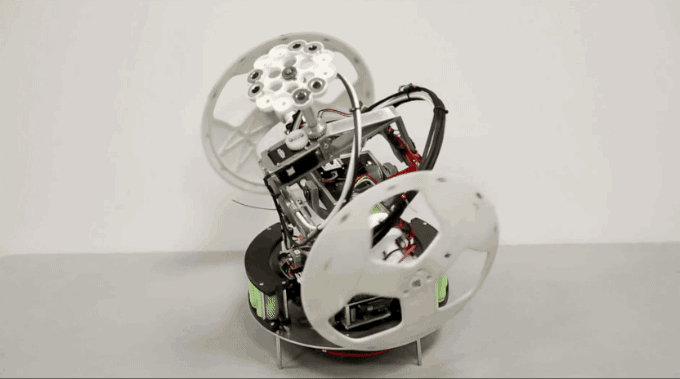Project Introduction: Arbo (RB-0)
Lately I've been haunted by the idea of building a little robot guy, specifically in the style of BB-8 from the latest Star Wars trilogy. There were a handful of life-size RC puppets created for the movies, however I'd like to build an autonomous example. I'm less interested in a replica movie prop, more interested in an exercise in project planning, system design and development. This allows me to dip my toes into things I've been itching to get into, namely embedded programming, networking, robotics, and some more artificial intelligence. Here's hoping this actually ends up in something physically tangible before the summer ends and my final year of university begins.
System Goals:
I'd like the robot to path around obstacles and track a user autonomously. The best way I can see to accomplish this is via Bluetooth communication. Because we're relying on the robot to perform autonomous navigation rather than a human with RC controls, the 'head' of the unit will house some sensors I don't think the movie props included. BB-8's design has the head and body completely separated from each other. I've chosen for the head to act as the system director, as it will house a good number of the sensors for the robot. The head of the robot will be the hub for BT communication, paired with the body to send commands to the motors, as well as paired with a user's phone, which it will use to estimate distance to the user. I'd like the head of the robot to include status LEDs, an ultrasonic distance sensor, gyroscope+accelerometer combo, as well as a microphone and speaker. The idea is for the head to ping for obstacles via echolocation, and establish distance from the user via BT. The head would take these two parameters into account and send commands wirelessly to another BT chip located in the body, which would relay commands through a motor controller to move the robot. If we get far enough, the microphone should be able to accept user commands / requests, convert speech to text, send requests to and receive responses from a cloud server via the user's mobile device, and respond accordingly.
Hardware:
I've been doing most of my shopping by scrolling through the Adafruit and Digikey catalogs. I've settled on using an Arduino as my central controller pretty early on, as this would be somewhat my first jump into embedded programming. I'll be using the ESP32-WROOM as my BT chip for both the head and the body, though the head will include an external w.FL antenna to extend the range. At this stage, the design for the head includes the following components:
Arduino Uno r3
BT Chip (Adafruit ESP32 Feather V2 w.FL Antenna)
Ultrasonic Distance Sensor (RCWL-1601)
Gyroscope + Accelerometer + Magnetometer Combo (BNO085)
Environmental Microphone (MAX9814)
Amp/Speaker
MicroSD interface
16p Port Expander (MCP23017)
Status aRGB LED 4x
Buttons 2x
The design for the body includes the following components:
BT Chip (Adafruit ESP32 Feather V2)
Motor Controller (Sabertooth Dual 25A Motor Driver)
Electric Motor 2x (E30-400-24-G16)
I'm fairly confident with all the components selected for the head at this point, but there's still some unanswered questions for the body's design. I've been working off this clip of the actual robot used in some of the the movie scenes, which looks to include two X-axis motors and a center differential which spin the ball from the center, a Y-axis motor at the lower rear which leans the body left and right, a Z-axis motor in the center that spins the head, and what I'm assuming is a geared ring under the lowest circular plate which the body spins on, though I'm unsure how necessary that is.
I've found a motor controller that I like, the Sabertooth 2X25 V2. 25A continuous with 50A peak for two independent motors, operates anywhere from 6-30V. Thermal and overcurrent protection, analog input. What really sold me is the Synchronous regenerative drive, meaning any downhill rolling, deceleration, and stopping will use the motors as generators and recharge the batteries. There's Arduino support, and I'm wondering how much of that I could leverage while sending/receiving commands via the ESP32. https://www.dimensionengineering.com/products/sabertooth2x25
Motor Selection:
Here's where I start to really get out of my area. Had no idea where to start when looking for motors. I've been using this calculator to estimate torque required for the robot. https://www.orientalmotor.com/motor-sizing/agv-sizing.html#QuickReport
Estimated Figures:
30lb vehicle weight
20in wheel diameter
15lb wheel weight (spitball, I'm picturing a honeycomb skeleton sphere with some aluminum or 3D printed parts for the shell?)
1 wheel
.57 coefficient of friction (Best I could find for metal on concrete, confirmation needed)
100% efficiency (No belts to slip, should I account for motor efficiency here?)
No transmission
Max slope 5* (ADA requirements)
Hold load after motor stopped, but not after power off (Comments welcome, almost no thought put into this requirement yet)
Variable speed, 90ft/min (1mph) ~ 350ft/min (4mph)
Stopping accuracy 3in (Total spitball)
Safety factor 1.5 (safety third)
Results:
Load Inertia : 60000oz/in² (is this metric useful in any way) Required Torque : 493lb/in = 7890oz/in = 56Nm
Accel Torque : 34lb/in = 544oz/in = 3Nm Load Torque : 294lb/in = 4716oz/in = 33Nm
Naturally, my only frame of reference here is BattleBots, so after some looking around I stumbled on https://www.ampflow.com/gearmotors/ampflow/. Looking through the options I think I've landed on the E30-400-24-G27. Using a pair cuts our torque requirements in half (engineers help me out here?), and hitting our new peak requirement of 28Nm happens at peak efficiency, around 30A. The motor still spins at 200rpm at this torque though, so I probably will end up needing some gear reduction happening which is less than ideal.
In the next chapter, we’ll go over the system design, including proposed navigation techniques using the onboard Bluetooth in combination with the ultrasonic distance sensor.






